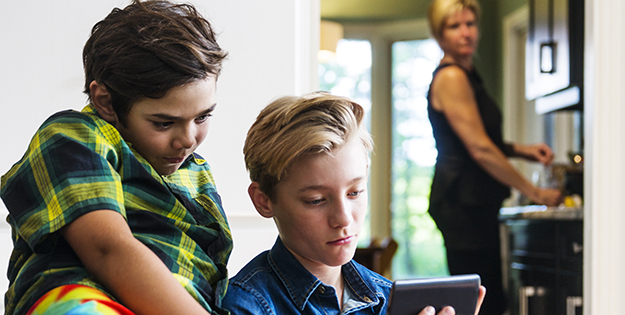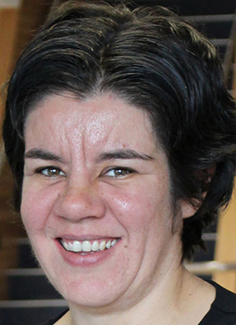Community
Copyright@ Australian Catholic University 1998-2025 | ABN 15 050 192 660 CRICOS registered provider: 00004G | PRV12008
Copyright@ Australian Catholic University 1998-2025 | ABN 15 050 192 660 CRICOS registered provider: 00004G | PRV12008

In a home somewhere in suburbia, a preschool-aged girl sits cross-legged on the couch huddled over an iPad, the device’s glow lighting up her face as she pokes and swipes at the screen.
The girl is playing an online educational app that helps kids to improve their literacy skills. She knows how to start the game by finding the relevant icon, tapping on it and choosing an activity, and she’s clearly having fun, smiling and singing along when she gets something right.
If this girl had been born 10 or 15 years earlier, before the emergence of mobile touchscreen devices, it’s unlikely she’d have been able to navigate an internet-based game on her own at this age. She would have needed the fine motor skills necessary to operate a mouse and a keyboard, and the literacy skills to type in what she wanted.
“This was really hard for very young children to coordinate,” says Professor Susan Edwards, a leading expert in the use of digital technology in early childhood.
“Before touchscreen technology, kids generally didn’t get on the internet until much later, until they were seven or eight, and still with a lot of help from adults.”
The difference with touchscreen devices is that they’re more intuitive and accessible to young children, who are adept at using touch to navigate them.
“Kids can read the pictures as instructions, respond to the audio and operate the technology quite independently, without any adult support,” says Edwards, Director of the Early Childhood Futures research program at ACU.
As a result, children younger than five are accessing the internet more than ever before — and the trend shows no signs of slowing.
Faced with mixed messages about the benefits and dangers this poses to kids, many families opt to play it safe and delay internet access for as long as possible.
But according to Edwards, this is no longer a realistic option. Even infants and toddlers are exposed to technology daily, often through the device-reliant adults who care for them.
“With these kids, technology is a major part of their lives from the very beginning, so the time when banning internet access was a solution to keeping children safe has well and truly passed— that horse has bolted,” she says.
As the lead advisor on the Federal Government’s $2.5million eSafety Early Years program, Professor Edwards is tasked with developing resources aimed at building a child’s understanding of online safety as they grow. Her concurrent ACU-led linkage project will bring together five universities and seven partner organisations including the Australian Federal Police, and develop an online tool based on best practice for children in a digital society.
“We’ve never had to deal with this before,” she says, “and so our current research is aimed at understanding the range of practices that parents and educators can engage in with young children, to ensure they have the healthiest and most appropriate use of technologies from early on.”
Experts have identified three main risks facing children that access the internet: contact, conduct and content risks.
Contact risks include accessing websites that harvest the data and activity of young children, or coming into contact with unknown people, including adults posing as kids.
“Any sort of unknown contact online can expose children to grooming,” Professor Edwards says. “They might be convinced to share personal information or provide contact details that should be kept private.”
For preschool-aged kids, conduct risks involve doing things that might compromise the technology they’re using.
“Things like accidentally clicking on a popup and downloading a virus, or making a very expensive in-app purchase,” she adds.

Content risks are perhaps the most common concern for young children accessing the internet. This involves the type of content they’re consuming, including videos or pictures they might find upsetting or uncomfortable, or repeated exposure to low-quality content.
“If a young child is free-ranging too much on YouTube Kids and watching a whole lot of toy unboxing videos over and over again because that’s what the algorithm keeps giving them, that can have a negative effect on them,” Edwards says.
“Are they getting exposed to material that is overly commercialised, or that doesn’t have fair cultural or gender representations of people? If that is the case, parents and carers need to step in and make sure the content they’re consuming is of higher quality.”
Like many children her age, the girl from the start of our story loves fire-fighters.
She asks her father if she can watch a video about the bushfires. Her dad helps her to find a short segment, one that’s appropriate for a pre-schooler.
The girl starts watching and Dad walks out of the room. Meanwhile, the segment finishes and rolls on to another video about the bushfires; one she finds scary and distressing.
“This type of thing can easily happen, where you’re out of the room for a couple of minutes and the child gets upset at something they’ve encountered,” says Professor Edwards, a parent-of-four.
“In that case, you could say to them, ‘Sometimes you might see something on YouTube you don’t like or that upsets you. If that happens, stop watching and ask for help.’ Then you can talk to the child about what they've seen and how they feel about it.”
Parents might also consider discussing how to learn when to press stop.
“We encounter this as adults too, where we’re on Netflix and we’ve made the decision to watch one episode, but the website is designed to keep you there so when it rolls on, you watch the next one,” Edwards adds.
“What we have to do is say, ‘We are in charge here, not the technology. We make the decision to press stop, so if you see something you don’t like, just press stop and come can get me.’”
Experts also advise teaching children that ‘the internet’ means a network of technologies that can interact with each other.
“It’s much easier to tell a young child to avoid talking to strangers online if they have an understanding of what ‘online’ is,” says Professor Edwards, who led a study that found only 40 per cent of children were able to describe the internet.
“Young children will say they have a sense of the internet, because people talk about it in their lives all the time, but they might say, ‘The internet’s in the iPad’, or ‘The internet's where you play games’.
“So they understand all the social practices associated with the internet but they don’t yet have a concept of it as a series of network technologies that anyone can use, including strangers who may not have our best interests at heart.”
The same study found that three out of four children would tell someone their address on the internet, and nine out of 10 would click on a pop-up even if they didn’t know what it was about.
“It’s just like when we’re teaching children to develop sun safety habits. We never avoid telling them that the sun can harm our skin; we explain that to them and ask them to wear a hat and sunscreen to protect themselves,” Edwards says.
“It’s the same with the internet. We need to explain what it is, how it works, and then we can teach them how to keep safe.”
Some other tips for cyber safety include:
Building understanding: If you’re helping a child to Google something, tell them you’re using the internet to research the topic and explain that the information is created and collected by lots of people. This may help children to build a stronger concept of what the internet is.
Playing together: Playing alongside children will enable them to ask questions on the go, and allow them to see appropriate online behaviour in action. You can also engage children with topics they are interested in, to help them to develop critical thinking skills.
Set limits: Giving children time limits for screen use can help them to develop self-regulation skills, including stopping when time is up. You can also encourage autonomy by giving them options for when they spend time online.
Activity and creativity: Try to incorporate digital technology with physical activity. If a child is learning to skip or ride a skateboard, make a video and play it back to them. Show them how to take pictures and use effects like slow motion or time-lapse. Online activities that encourage creativity can empower young children to use technology to learn.
Stay close: Ensure children use digital devices in communal areas and not in bedrooms, and never in the hour before bedtime, which can disrupt a child’s sleep.
Choose quality: Look for quality content, including games and apps that help children build their understanding of the world or engage in representational thinking. The ABC and CBeebies are good examples, as well as the websites of museums and galleries.
Professor Susan Edwards is a researcher at ACU’s Institute for Learning Sciences and Teacher Education.
She has more than 70 publications in peer-reviewed journals and is the author of several books, including Young Children Playing and Learning in a Digital Age.

She is the chief investigator for an ARC linkage grant, ‘Young children in digital society: An Online Tool for service provision.’ The project is recognised as being in the national interest and aims to identify the practices enacted and shared among young children, their families and educators in digital society. The Federal Government’s eSafety Early Years resources are due to be delivered in 2020. Register your interest.
Copyright@ Australian Catholic University 1998-2025 | ABN 15 050 192 660 CRICOS registered provider: 00004G | PRV12008